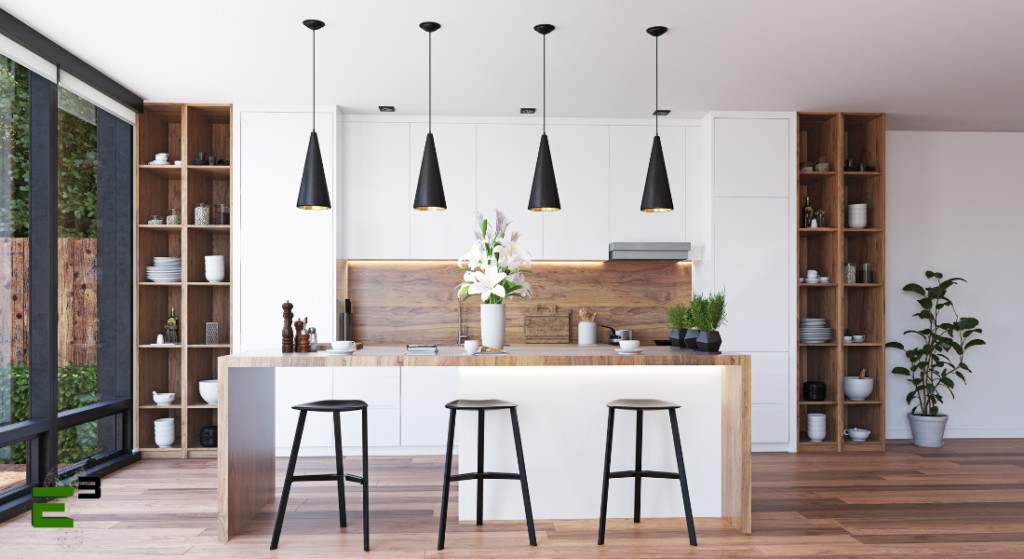Energy efficiency is a growing concern in our modern society, where we seek ways to reduce energy consumption and minimize environmental impact. Put simply, energy efficiency refers to the intelligent and effective use of energy, aiming to achieve the same results with less consumption. In this context, it is important to consider how the choice of colors in a home can influence its energy efficiency.
Color is a powerful element in architecture and interior design, capable of affecting not only aesthetics but also the comfort and functionality of a space. Concerning energy efficiency, color plays a significant role, influencing how light is reflected, absorbed, and distributed within a home. Light colors, for example, tend to reflect more light, helping to maximize natural lighting and reduce the need for artificial illumination during the day. Conversely, darker colors absorb more light, potentially leading to darker spaces and increased reliance on artificial lighting.
Therefore, when designing or renovating a home, it’s essential to carefully consider the impact of color choices on energy efficiency, aiming for a balance between aesthetics and practicality.

Impact on Natural Lighting
The selection of colors for walls and furnishings can significantly impact the level of natural light infiltration within a household. Lighter hues such as white, pastel shades, and gentle variations of yellow and green have a tendency to reflect a greater amount of light, thereby aiding in the expansion of the perceived space and the optimization of natural illumination. Conversely, darker tones such as various shades of brown, deep blues, and black tend to absorb more light, potentially leading to dimmer environments and necessitating heightened reliance on artificial lighting throughout the daytime hours. Hence, when contemplating the color palette for a residence, opting for lighter tones can contribute not only to a brighter ambiance but also to enhanced energy efficiency, as it reduces the requirement for artificial lighting. This deliberate choice promotes a more environmentally sustainable approach to living while concurrently fostering a visually pleasing and comfortable living space.
Projects and Exchanges for Optimization
To enhance the energy efficiency of a home through careful color selection, there are several strategies that can be implemented. For example:
Replace heavy curtains with lighter, translucent fabrics, allowing for better natural light entry and reducing the need for artificial lighting.
Opt to paint ceilings and walls with light tones, providing greater light reflection and reducing dependence on artificial lights.
Choose furniture and coverings with light shades to aid in light dispersion and create a sense of spaciousness in the spaces.
These changes not only contribute to a brighter and airier home but also to the reduction of energy consumption, resulting in benefits for both the environment and home maintenance costs.
Use of Colors in Hear Reduction
The strategic utilization of colors in heat reduction is a critical aspect to consider alongside lighting and energy efficiency when designing residences. By carefully selecting color schemes, homeowners can effectively manage the thermal conditions within their homes. Light and neutral tones applied to roofs and façades can facilitate the reflection of sunlight, thereby minimizing heat absorption and maintaining cooler interiors. Conversely, opting for darker colors on external surfaces exposed to intense sunlight can enhance heat absorption, consequently reducing the reliance on air conditioning systems. These deliberate chromatic decisions significantly influence the thermal regulation of a household, fostering a more comfortable indoor environment while simultaneously decreasing the dependency on cooling energy. Ultimately, the thoughtful application of colors not only enhances the aesthetic appeal of a home but also contributes to its sustainability by optimizing thermal comfort and minimizing energy consumption. Therefore, when planning residential designs, careful consideration of color choices is paramount to achieving an optimal balance between thermal performance and visual aesthetics.
The choice of colors in a house can make a significant difference in its energy efficiency. By considering the impact of colors on natural lighting, heat reflection, and comfort sensation, homeowners can make informed decisions that not only enhance the indoor environment but also reduce energy consumption and promote sustainable practices.
Therefore, when designing or renovating a house, the power of colors in contributing to greater energy efficiency and a more conscious lifestyle should not be underestimated. Choosing colors that maximize natural light entry, reduce heat absorption, and create a welcoming atmosphere can not only make the house more comfortable but also reduce the need for artificial lighting and climate control systems. This approach not only benefits the environment but can also result in significant long-term energy savings.
As a company dedicated to promoting energy efficiency, we offer complimentary energy audits aimed at enhancing the efficiency of your household. This enables you to not only save on costs and resources but also play a part in preserving the environment. If you reside in New York, it’s worth noting that the government offers various incentives to help you make your home more energy efficient. These incentives include tax refunds, discounts, and financing options through initiatives like Clean Heat, Comfort Home, and GJGNY Financing. These programs aim to support residents in upgrading their homes to be more environmentally friendly and cost-effective in terms of energy consumption. We’re here to support you in navigating these opportunities by verifying your eligibility and assisting with the application process if you qualify. By taking proactive steps, we can collectively work towards a more sustainable and cost-effective future.



